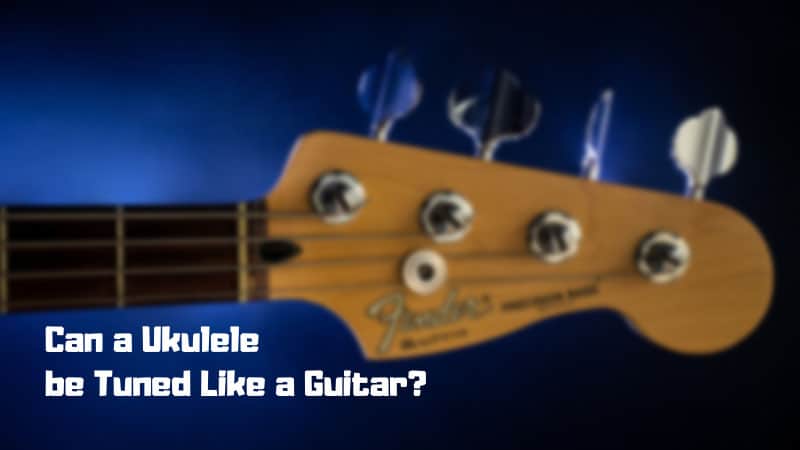If you’ve just got the hang of reentrant tuning for your ukulele, D tuning should be a piece of cake. But can a ukulele be tuned like a guitar? Let’s find out!
Ukuleles are really versatile for an instrument that has only four strings. Just like guitars, they can be tuned in all different ways.
But if your question is- can a ukulele be tuned like a guitar, we’re going to say yes and no!
Guitars are tuned in a linear pattern where pitch increases from the top string to the bottom string.
Ukuleles can be tuned like a guitar if you lower the pitch of the G string by one full octave and leave the rest as is. Also known as low-G tuning, this pattern is quite popular for ukuleles.
While you do get a linear pitch with low G tuning, an authentic guitar sound depends on more factors like string material, length, scales, and chord shapes.
Today we’ll be showing you how to tune your ukulele like a guitar and why tuning is different for them, to begin with!
Off-Topic: Some Discounted Ukuleles and Stuff that You May Like
No products found.
The Basic Tuning Difference Between Ukulele and Guitar
When it comes to tuning, both a guitar and a ukulele offer exciting options! Standard tuning involves the basic pitch of your instrument unless specified otherwise. It means if your acoustic guitar is fresh out of the store, it’s likely tuned to E-A-D-G-B-E. The same applies to bass guitars, electric guitars, and even ukuleles.
However, standard tuning is a different thing in the ukulele world. Rather than E-A-D-G-B-E, most ukes are tuned to G-C-E-A. Let’s see why that is!
Number of Strings

Tuning your ukulele is as much about strings as it’s about the pitch. For example, the number of strings on a ukulele is four. So, however you arrange your ukulele strings, the instrument falls short of two strings at any given time.
Guitar
A standard 6-string guitar is tuned to E-A-D-G-B-E. It’s also known as linear tuning because the strings advance from the lowest note to the highest note.
The basic tuning pattern for acoustic, classical, and electric guitars is the same old E-A-D-G-B-E. You can try endless alternative tunings with either instrument. And that’s pretty cool.
Bass guitars, on the other hand, could make you Eat A Dead Grasshopper. At least that’s how the mnemonic for bass guitar tuning goes.
A 4-string bass guitar is tuned to E-A-D-G (the lowest four strings on an acoustic guitar, if you may). The difference is that bass strings are one octave lower and they’re tuned in fourths.
Ukulele
The standard ukulele tuning is G-C-E-A. You’ll notice that concert, soprano, and tenor ukuleles follow this tuning pattern.
Baritone size ukuleles, however, are tuned in an entirely different way. They follow the D-G-B-E tuning which is basically the guitar’s E-A-D-G-B-E tuning minus the top two (Low E and A) strings.
If you want to branch out to popular music styles, there’s also a low G tuning and a D tuning. The latter is extremely popular in Canada and England, and we can’t wait to tell you all about it!
6-String Ukulele
Not only does tuning vary from guitar to ukulele but also contrast with instruments having the same number of strings.
A good example of this tuning difference would be the case of guitalele- a 6-string ukulele! Despite having three pairs of strings like a guitar, guitaleles are tuned to A-D-G-C-E-a.
The top four guitalele strings (G-C-E-a) are similar to ukulele strings. Although, the G isn’t tuned up an octave. Players sometimes relate the 6-string ukulele tuning to guitar tuning. It’s because the notes are in the same intervals but they’re up a fourth.
Order of the Strings
Guitar strings are tuned in a linear manner. It means they follow an ascending order of notes from the low E (6th string) to the high E (1st string).
As you move down from the 6th string to the 1st string, the pitch increases in equal intervals. That’s why the first string is the thinnest and the loudest string on classical guitars.
So, in terms of pitch, guitar strings go like:
Low E<A<D<G<B< High E
Or, if you’re more comfortable with numbers- the 1st string has the highest pitch, the 2nd string has the second-highest pitch and the 6th string has the lowest pitch.
Alright, let’s talk about ukuleles! The fourth/top string on your uke is G, the 3rd string is C, the 2nd and the 1st strings are E and A.
Ukuleles have an interesting tuning pattern. The top string, G, is tuned higher than the next string, C. Notice how G being higher in pitch than C breaks the linear (lowest pitch to highest pitch) order?
Keep an eye out for the Reentrant Tuning section where we discussed this irregularity in detail!
History
Surprisingly, history is another reason why tuning is different for a guitar and a ukulele. Ukuleles date back to the 1880s. In the early days, there existed a similar stringed instrument called the lute.
From there, we see the Baroque guitar and the Portuguese guitar braguinha- all of which followed a reentrant tuning. Portuguese immigrants brought their guitars to Hawaii, the birthplace of the ukulele.
So, it’s evident that ukes have descended from reentrant instruments. Guitars, however, have a Spanish origin and are traced back to medieval instruments called Guitarra Latina and vihuela. Their linear tuning strongly influenced the modern-day E-A-D-G-B-E guitar tuning.
Chord Formations
If you want a guitar sound on your tenor ukulele, the old chord shapes have to go. Not to mention, guitar chord fingerings on a uke can sound like a whole new ball game.
For two instruments that are so much alike, how come creating music is different?
To answer this question, let’s have a look at the standard G-C-E-A tuning.
Here, the fourth string (G) is up by an octave. And the third string ( C) is lower in pitch among all four strings. You can say that the C string is tuned to middle C. Both E and A strings are tuned higher than this middle C note.
Now would be a good time to point out that the standard ukulele tuning is everything but linear.
This is the reentrant tuning- also known as High G tuning in ukulele songs. Reentrant tuning is the reason why guitar chords and ukulele chords are different for the same sound. When you play a guitar chord shape on your uke, the tone you get is a fourth higher.
The Real Reason Why Tuning Is Different for Guitars and Ukuleles
A guitar is a 6-string instrument with a tuning pattern that goes like E-A-D-G-B-E. The E, A, D, G, B, E strings are respectively the 6th, 5th,..,1st string from top to bottom. The pitch increases from the top string (low E) to the bottom string (A) in regular intervals. And, that’s it. That’s the linear tuning everybody talks about.
Moving on to the next instrument, the standard tuning is G-C-E-A for ukuleles. G has a higher pitch than C, or middle C as they say it. However, C is tuned lower than E and A both.
Now, if the G string was down an octave, a ukulele would be tuned exactly like a guitar. The top four guitar strings with a capo on the 5th fret, to be specific.
With this new linear tuning, the chord fingerings that work on your guitar can be transferred to a ukulele.
However, it’s difficult to tune the G string lower than the middle C on a small uke. Besides, playing notes that low on a 21-inch tenor can feel very uncomfortable!
Thanks to the high G and the middle C, original ukulele chord shapes are super easy on the fingers!
Reentrant tuning comfortably fits both major and minor chords rooted on the 3rd and 4th strings.
Everything You Need to Know About Ukulele Tuning
Ukuleles are half the size of a guitar. And yet they provide plenty of tuning options beside the good old G-C-E-A.
A few of which will indeed make your ukulele sound like a guitar!
Without further ado, let’s explore the most popular tuning patterns for the ukulele.
Reentrant/Standard C Tuning
The C string on a concert ukulele kicks out a lower pitch sound than the G string. In fact, it has the lowest pitch in the standard G-C-E-A tuning.
The remaining two strings (E and A) are tuned in a linear pattern like guitar strings. And there you go! That’s the reentrant tuning for soprano, concert and tenor ukuleles.
The specialty of reentrant tuning is that the two outside strings ( g and A) are tuned higher than the middle two strings (C and E).
Linear Tuning
While a common tuning for most ukes is g-C-E-A, it’s D-G-B-E for baritone ukuleles.
The standard guitar tuning goes like E-A-D-G-B-E. Here, the A string has a higher pitch than the low E string. Similarly, the pitch of the D string tops that of the A string.
So, both a guitar and a baritone ukulele follow tuning patterns where each successive string rises in pitch. It’s also known as linear tuning.
Linear tuning is partly true for g-C-E-A ukuleles in the sense that the E and A strings are indeed in an ascending order.
D Tuning
The G string is the top string for most types of ukuleles. It’s the closest string to your head when you play this instrument. And the A string is the bottom string- the closest one to the floor.
Now, all notes in D tuning are tuned two frets higher than reentrant tuning. So, from the standard G-C-E-A, the open strings move towards A-D-F#-B.
Low-G Tuning
A re-entrant tuning for ukulele involves a High G note that’s above the middle C note. In low G tuning, uke players tune their G string to a lower pitch than the middle C. The new string is tuned a whole octave lower than the High G.
This way, all four strings from G to A are in an ascending pitch level.
Moving forward, the High G string was thin and tightly wound as it enhanced the pitch sound. So, during the low G tuning process, you need a thicker gauge of string for the new G.
What is Alternative Tuning for Ukulele?
The standard G-C-E-A tuning offers a distinct range of notes. But, that’s not everything a ukulele has to offer.
An alternative tuning is when you drop the string tension on certain strings so that they sound differently.
The Drop-D tuning is a popular one for guitars. It changes the E-A-D-G-B-E tuning to D-A-D-G-B-E. As you can see, the pitch of the low E string was dropped to D keeping everything else the same.
Similar alternative tuning patterns are available for the ukulele. They make riffs, chord progressions and scales sound more fun.
Scientific Pitch Notations
The most important thing you should learn before alternate tuning is scientific pitch notations. These are numbers we assign to every note in a tuning pattern to understand their octaves.
So, instead of saying E A D G B E, you can say that it’s E2 A2 D3 G3 B3 E4. Here, E4 has the highest pitch, and E2 is two octaves lower than E4.
If you’ve read about the Nashville tuning, you know it also goes like E-A-D-G-B-E. The difference is that the bottom four strings (E, A, D, G) are tuned up an octave.
Applying scientific pitch notations, Nashville tuning becomes E3 A3 D4 G4 B3 E4.
Alternative Tuning Chart for Ukulele
Now that you know all about pitch notations, it’s time we shared our complete guide to alternate tuning!
Why You Need to Learn Relative Tuning for Ukulele
Tuning a ukulele is fairly easy these days with all the chromatic tuning and youtube tutorials. Even those free tuning apps are unbelievably accurate. However, there might be times when these shortcuts are unavailable, and you really need to tune your ukulele based on your instincts. We can show you a new, easy way to tune your instrument. Make sure to keep reading!
Relative Tuning Your Ukulele
With this method, you won’t be needing outside references anymore, and that really takes away all the hassle that involves tuning. Now, relative tuning is when you tune each of the four strings relative to the other. Here’s how it’s done:
Remember how the A string (1st) sounds? Good.
First, play an A note on the E string (2nd). Now, play and turn the tuning key for the E string until it sounds like the A string (1st).
Next, play the C string (3rd) on the 4th fret to get an E note. Tune the C string until you get the sound of the E string (2nd).
Lastly, fret the G string (4th) on the second fret. The sound you get is an A note. Play and turn the tuning key for the G string until it sounds like the A string (1st).
3 Things That Affect Ukulele Tuning
Tuning acoustic instruments can take a lot of time. As the strings get older, you need to tune them more frequently than before.
If you’ve just bought a new ukulele, you’re probably still in the honeymoon phase and can’t relate to this problem.
But sooner or later, you’re going to have to tune your ukulele. And these are all the things that could go wrong while tuning:
Loose Tuning Pegs
The four little keys you see in the ukulele’s headstock are the tuning keys. Each key controls a single string that is tied to the bridge on the other end. Tuning keys can rotate clockwise and anti-clockwise. They can loosen the strings or tighten them.
When you fingerpick tight strings, they sound sharper than slacked strings. Tuning a ukulele is all about finding the right tension, and of course, using the right gauge of strings.
Thickness of Strings
The tension and thickness of the strings say a lot about the pitch, and in turn, tuning. For example, a thicker string means that the notes in that particular string will be low. And a thinner string means that you’ll have sharp, bright music.
Ukulele players will keep different gauges of Aquila strings close by. Restringing often helps them to tune the instrument better.
Most ukuleles use soft nylon strings in various thicknesses. Note that the C string in re-entrant tuning is made thicker than the High G string. Otherwise, being tuned to middle C (the lowest note on a reentrant-tuned ukulele) would have been impossible.
Length of Strings
Ever wondered why ukuleles have a sweeter tone than guitars? Consider the following two examples.
For a 19-inch scale, the strings on a baritone uke are about 30 inches long. Now, if you look at soprano ukuleles, you’ll notice that soprano ukulele strings are about 21 inches long. The shorter the strings, the brighter the instrument!
Concert, soprano and tenor ukuleles sound way more cheerful than baritone ukuleles for this reason. Since the average string length varies from one type of ukulele to another, players often use different tuning methods to find the right notes.
Bottom Line
You can definitely tune your ukulele like a guitar by tuning it to low G. In this new pattern, the G string has the lowest pitch- just like the low E string on a guitar.
Tuning your ukulele like a guitar, you get five extra low notes and fuller-sounding chords. It’s enough reason for us to switch to low G! Why don’t you give it a try? Best of luck!
Last update on 2024-07-13 at 08:29 / Affiliate links / Images from Amazon Product Advertising API



